
The summer of 2016 marked the first time that University of Virginia (UVA) undergraduates embarked on four internships in American history made possible by funding from the John L. Nau III Center for Civil War History. The Center was pleased to collaborate on this project with Dr. Lisa Goff at UVA’s Institute for Public History. In addition to one internship located on campus, three of the Center’s interns took positions in or near Richmond and Fredericksburg to conduct research or educate the public about the ongoing importance of the American Civil War.
One such intern, Emily Dance, spent the summer hard at work in the Civil War era collections of the Virginia Historical Society (VHS) in Richmond. There she described, collated, and organized materials previously held by the Museum of the Confederacy. Emily dealt with items on an individual level, a painstaking process that was nonetheless very rewarding during the “absolutely fantastic time” she had at the VHS. “This level of detail was essential for the George F. Markham, Jr. Collection,” Emily recalled, “because it houses some hot-ticket items that will attract researchers, such as letters from William Tecumseh Sherman, Robert E. Lee, Jefferson Davis, and more.”
Emily’s favorite task involved working in the Soldier’s Letter Collection. This collection of 300 Confederate letters was supposedly located in an abandoned mailbag by Union forces at the end of the war. Emily not only found the origin of these letters fascinating, but she also appreciated the fact that the letters were written by “completely ordinary people living in the midst of battle and on the home front.” “Here [was] the kind of bottom-up narrative that every history student dreams about, and it was all at my fingertips!” said Emily. “I cannot express to you how privileged I felt at the end of this project, and how personally enriched.” Indeed, Emily’s time in Richmond was so rewarding for the VHS that they hired her to be an intern this fall semester working with their twentieth-century political collections. “We are enormously grateful to the Nau Center for your provision of a summer intern for this project,” stated E. Lee Shepard, VHS’s Vice President for Collections. “I hope it is clear that it was an investment that certainly paid wonderful dividends to the VHS, and to Civil War scholarship.”
Students Wes Gobar and Sarah Anderson also had rewarding experiences at the Civil War battlefields of Fredericksburg and Richmond respectively, working directly with National Park Service employees to help interpret these important battles for today’s tourists. Both students gained valuable experience in public history while greatly impressing the sites’ directors with their dedication and hard work. Wes’s work at Fredericksburg and Spotsylvania National Military Park was actually a continuation of a project he had started there during the previous summer. Chief historian John Hennessy came away very impressed with the “great job” Wes did during his second stint in Fredericksburg. “[Wes] is inquisitive and smart, he possesses a good deal of initiative, worked hard, was entirely reliable, and interacted very well with the public. He readily engaged visitors in what were once considered to be difficult topics, and he did so without flinching—directly, effectively, and with poise,” noted Hennessy. “We could not have expected more, and indeed got more than we might rightly have expected.”
In addition to assisting in children’s education and other interpretative programs once a week at some of the various sites comprising the Richmond National Battlefield Park (RNBP), Sarah primarily helped the Park’s chief historian research the wartime lives of Richmonders who worked at the city’s famous Tredegar Iron Works. “The project began with transcribing a payroll ledger that covered August 1863-1864 to extract the names of as many employees as possible,” Sarah remembered. “By the time I finished transcribing the ledger, I had over 8,000 entries; many of these entries were repeats of the same individuals over different pay periods, however, so I ended up with about 600 different names.” Sarah used additional historical sources such as federal censuses, an 1860 city directory, the Chronicling America newspaper database, and the website Find-A-Grave to learn as much as she could about these understudied Confederate civilians. “While I couldn’t find information on a good percentage of the employees on my list,” Sarah explained, “I was very happy with the final results.”
The experience proved to be a rewarding one for both Sarah and the staff of Richmond National Battlefield Park. “We could not have been more pleased with the way the internship went,” said David R. Ruth, the park’s superintendent. “Sarah’s professionalism and research ability helped us in several ways that benefited the park’s history program.” In the end, Sarah herself was very happy to have this “experience in the many different facets of public history” at the Richmond National Battlefield Park. “I had a wonderful experience and am very thankful to the Nau Center for sponsoring my internship and all of the staff at RNBP and Maggie Walker for having me this summer!”
In their reports on Emily, Wes, and Sarah, all three site directors expressed a hope that the Nau Center would continue to support additional internships in the summer of 2017. The Center encourages all interested undergraduates to keep their eyes on the Institute for Public History’s website for more information about our summer 2017 internships. We also encourage you to check out IPH’s Tumblr blog to learn more about all of their many interns’ rewarding experiences this past summer.
